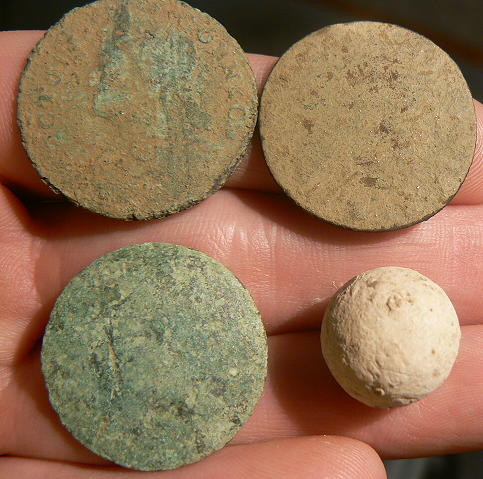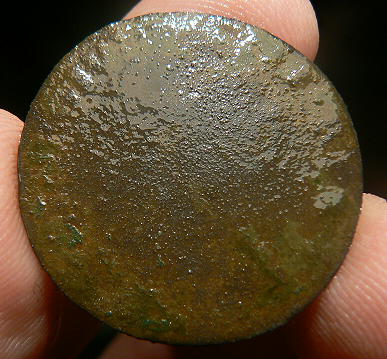Two colonial coppers today. That is a personal record. Colonial coppers are quite hard, at least for me, and at least in Chester County. Out of the nearly 20,000 coins I’ve dug, I think I’ve dug less than 10 of ’em, and one of them was dug in New England, where they are much more common. Sadly, like all CC coppers, they are abused beyond belief, but old coins are still fun to find, and part of the fun is figuring out what they are. Also dug a musket ball (and a rather nice one, as these things go), and an old button.
The first one is a 1786 draped bust Connecticut copper. If you use your imagination, you can see “CONNEC:” on the right, and its placement, with the colon, is consistent with this variety.
The second copper took a bit of work to identify. Originally I thought it would have to be scored a smootie, tho I thought I could make out a bust that is consistent with a liberty cap or draped bust large cent.
But, it turned out to be consistent with a Machin’s Mill variety, a knockoff of a King George III, made circa 1786/1787. You can make out the “IV” in “GEORGIVS”, the “II” in “III”, and the “REX” (well, you can’t really, unless you know what to expect on these things). This, in the size of this coin, is also consistent with a Virginia halfpenny (1773), and a Vermont copper variety (1788), but drawing a straight line from the V across the bust (yeah, there is a bust there), lines up with a line in the King’s robe, and transects below the “REX”, which is only consistent with a couple of Machin’s MIlls varieties, so that’s how we score it.
These are my 67th and 68th career coppers, and what is interesting, is that 20 of them have been found at this one site. Not only that, 19 of those 20 have been found in a rather small area (along with several other domestic artefacts). That is astounding, as these things go. Of those 19, many are unidentifiable, but of those that are, the newest is 1787 (and common sense would suggest that the smoothies are even older)
So, what was here? Who knows, but no question in my mind that something was. I’ve never seen anything on a map, except for one 1700s map that shows a road, but no dwellings. That road does not appear on early 1800s maps. However, 19 coppers (and perhaps more), is inconsistent with a 1700’s dwelling that may have been along the road. That’s a ton of money to have been lost in those days, for a single dwelling. It is a mystery likely to never be solved (at least by me), and believe me, I’ve spent a good bit of time at historical societies poking at it over the last 3 years.


